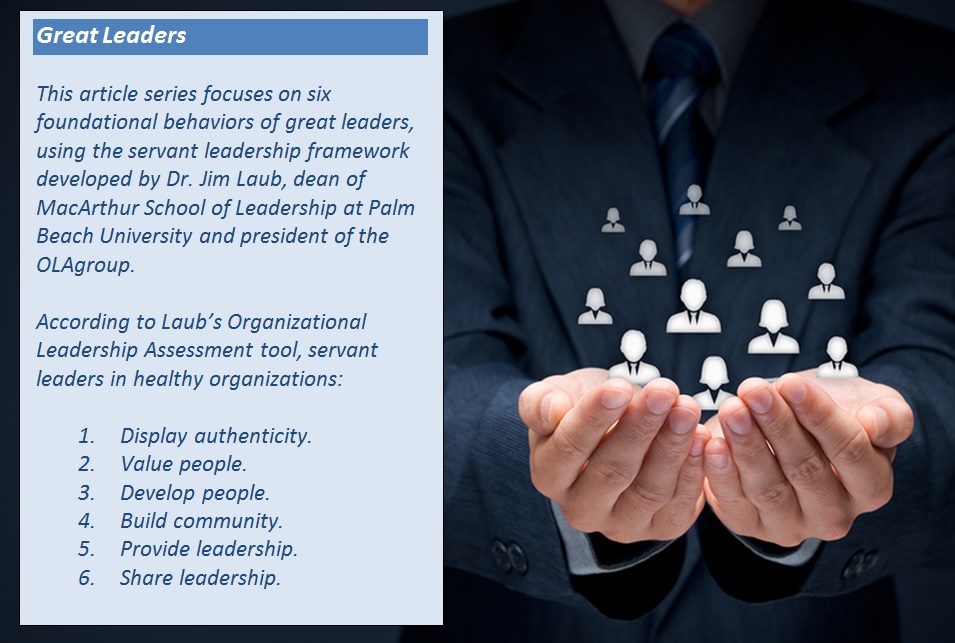As we build on the ideas presented in this series of articles, we focus on the third thing that great leaders do differently: They develop people.
(All six traits of great leaders are summarized in the textbox at the end of this article.)
Executive Summary
In the third installment of a six-part series of articles, Executive Coach Marcel Schwantes continues to delve into the best practices of servant leaders. Such leaders develop the people they lead, he says, describing three ways in which they demonstrate this.In Part 1, Schwantes discussed how great leaders display authenticity.
In Part 2, he outlined how great leaders value their people, according to the Organizational Leadership Assessment created by Professor Jim Laub.
WEBINAR BONUS: Sign up here for “Six Servant Leadership Practices That Drive Performance and Increase Your Bottom Line.“
There are three exceptional ways that great leaders go about developing their people:
1. They provide opportunities for learning and growth.
What you’ll find in most healthy organizations is a high commitment to growing their employees. If you happen to work in such an environment, you’ll probably notice a strong bond between top leadership and training and human resources functions working together to:
- Identify their employees’ gifts, talents, and strengths for the best job fit so that they can reach their potential.
- Champion a “learning spirit” within the organization, sending a clear message that “growing our people is one of our highest priorities.”
- Give meaning and purpose to the employees’ work, adding further motivation.
- Provide ongoing training, coaching and mentoring opportunities that are aligned with job purpose, performance measures, best-in-class customer service, and fulfilling the organizational mission.
2. They build up others through encouragement and affirmation.
The Gallup Organization has something to say about this. Their researchers spent decades accurately measuring employee engagement, which resulted in their Q12 Engagement Survey. They have interviewed more than 25 million employees around the world to find the core of a great workplace.
The 12 questions are designed to be posed to employees. And from the perspective of the employee, many of the questions, I will submit to you, point to the principles of encouraging and affirming employees to be the best they can be.
The results can also be boiled down to 12 “look-in-the-mirror” questions that every leader, manager, executive or HR professional can ask to understand how their companies measure up the key elements needed to keeping their most talented employees.
If you’re a manager, and your employees were asked the following about you, how would you do?
- In the last seven days, have I received recognition or praise for doing good work?
- Is there someone at work who encourages my development?
- At work, do I have the opportunity to do what I do best every day?
- In the last six months, has someone at work talked to me about my progress?
- This last year, have I had the opportunity at work to learn and grow?
The research also makes a strong business case for growing leaders in management roles. Employees who responded more positively to these questions worked in business units with higher levels of productivity, retention and customer satisfaction. The opinions formed by employees pointed to their immediate managers as the critical player in building and maintaining a great workplace. Once again, as the old saying goes, people leave managers, not companies.
3. They Have Honest Conversations During the Onboarding Process.
First of all, if you’re new to onboarding, we’re not talking about orientation during the first day or week of hire. Some effective onboarding can extend three-to-nine months after a hire date, some longer. Research is saying that a typical employee’s mind isn’t made up about staying or leaving a new company until month six! Companies are catching on to this emotional element and doing something about it.
I want to bring out some key questions that you should ask to find out if you are doing the things that lead to a great new hire experience. These questions are meant to trigger a response for you to be more intentional about having conversations that lead to high employee engagement during those crucial first few months.
- Do you as a leader/manager engage your new hires in “How can we/I help you with your professional development interests?” conversations in the first month?
- Do you as a leader/manager engage new hires in conversations about what motivates them within the first 1-2 weeks of employment?
- Do most of your employees have development plans? If so, do these plans get discussed periodically one-on-one?
- Are you, as leader/manager, actively helping employees to advance their plans by talking with them?
Let’s end with a question to think about: What are some great techniques that you currently use to develop your people?
(In September, Carrier Management will publish another installment of this article series: “How Great Leaders Build Community.”
On September 8, 2015 at 1:30 p.m. EST, Schwantes will host a webinar for Carrier Management readers titled “Six Servant Leadership Practices That Drive Performance and Increase Your Bottom Line. Sign up at http://www.leadershipfromthecore.com/webinars/.)






















 Study: Average Cyber Breach Insurance Coverage Gap is 350%
Study: Average Cyber Breach Insurance Coverage Gap is 350%  Survey: Majority of CA/FL Homeowners See Rise in Insurance Costs, Coverage Changes
Survey: Majority of CA/FL Homeowners See Rise in Insurance Costs, Coverage Changes  What Industry Executives Are Saying About Loss Reserves, Social Inflation
What Industry Executives Are Saying About Loss Reserves, Social Inflation  Executives on the Move at AIG, White Mountains, Vermont Mutual
Executives on the Move at AIG, White Mountains, Vermont Mutual 













